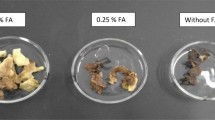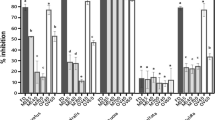Abstract
Brown algae represent a valuable source of various biologically active compounds. Their accumulation is influenced by many environmental factors. The purpose of this study was a comparison of the total chemical composition of brown algae from the White and Yellow Seas to substantiate the possibility of their use for production of new pharmaceutical substances. Using a scheme, which involves consecutive supercritical fluid, acid, alkaline and water extractions, various components of brown algae have been isolated including a protein-polysaccharide complex, which, in the case of Laminaria digitata and L. saccharina, consisted of cellulose and proteins for more than 80%. FTIR spectroscopy has confirmed the qualitative composition of the complex and indicated its purity. Significant differences in the elemental and component composition affected by growing conditions of macrophytes have been revealed. Chemical compounds obtained from brown algae biomass, especially the protein–polysaccharide complex, have a high potential as a basis for new pharmacological preparations for health protection purposes. Based on the earlier obtained data, one can suppose this complex has both enterosorption and immunomodulatory activity.



Similar content being viewed by others
REFERENCES
The State of World Fisheries and Aquaculture 2018. Meeting the Sustainable Development Goals, Rome: Food and Agriculture Organization of the United Nations, 2018.
Monteiro, J.P., Rey, F., Melo, T., Moreira, A.S.P., Arbona, J.F., Skjermo, J., Forbord, S., Funderud, J., Raposo, D., Kerrison, P.D., Perrineau, M.M., Gachon, C., Domingues, P., Calado, R., and Domingues, MR., The unique lipidomic signatures of Saccharina latissima can be used to pinpoint their geographic origin, Biomolecules, 2020, vol. 10, no. 1, pp. 1–17. https://doi.org/10.3390/biom10010107
Anastyuk, S.D., Shevchenko, N.M., Zvyagintseva, T.N., and Ermakova, S.P., The comparison of structure and anticancer activity in vitro of polysaccharides from brown algae Alaria marginata and A. angusta, Carbohydr. Polymers, 2016, vol. 153, pp. 258–265. https://doi.org/10.1016/j.carbpol.2016.07.103
Wu, G.J., Shiu, S.M., Hsieh, M.C., and Tsai, G.J., Anti-inflammatory activity of a sulfated polysaccharide from the brown alga Sargassum cristaefolium, Food Hydrocolloids, 2016, vol. 53, pp. 16–23. https://doi.org/10.1016/j.foodhyd.2015.01.019
Manlusoc, J.K.T., Hsieh, C.L., Hsieh, C.Y., Salac, E.S.N., Lee, Y.T., and Tsai, P.W., Pharmacologic application potentials of sulfated polysaccharide from marine algae, Polymers, 2019, vol. 11, no. 7, pp. 1–21. https://doi.org/10.3390/polym11071163
Stack, J., Tobin, P.R., Gietl, A., Harnedy, P.A., Stengel, D.B., and Fitzgerald, R.J., Seasonal variation in nitrogenous components and bioactivity of protein hydrolysates from Porphyra dioica, J. Appl. Phycol., 2017, vol. 29, no. 5, pp. 2439–2450. https://doi.org/10.1007/s10811-017-1063-0
Olivares-Molina, A. and Fernández, K., Comparison of different extraction techniques for obtaining extracts from brown seaweeds and their potential effects as angiotensin I-converting enzyme (ACE) inhibitors, J. Appl. Phycol., 2016, vol. 28, no. 2, pp. 1295–1302. https://doi.org/10.1007/s10811-015-0665-7
Beaulieu, L., Bondu, S., Doiron, K., Rioux, L.E., and Turgeon, S.L., Characterization of antibacterial activity from protein hydrolysates of the macroalga Saccharina longicruris and identification of peptides implied in bioactivity, J. Funct. Foods, 2015, vol. 17, pp. 685–697. https://doi.org/10.1016/j.jff.2015.06.026
Paniz, O.G., Pereira, C.M.P., Pacheco, B.S., Wolke, S.I., Colepicolo, P., and Orlandi, M.O., Cellulosic material obtained from Antarctic algae biomass, Cellulose, 2019, vol. 2, no. 1, pp. 1–14. https://doi.org/10.1007/s10570-019-02794-2
Bogolitsyn, K.G., Kaplitsin, P.A., Parshina, A.E., Druzhinina, A.S., and Ovchinnikov, D.V., Enterosorption properties of arctic brown algae fiber, Russ. J. Appl. Chem., 2017, vol. 90, no. 11, pp. 1819–1825. https://doi.org/10.1134/S1070427217110143
Bogolitsyn, K., Dobrodeeva, L., Druzhinina, A., Ovchinnikov, D., Parshina, A., and Shulgina, E., Biological activity of a polyphenolic complex of arctic brown algae, J. Appl. Phycol., 2019, vol. 31, pp. 3341–3348. https://doi.org/10.1007/s10811-019-01840-7
Cian, R.E., Hernández-Chirlaque, C., Gámez-Belmonte, R., Drago, S.R., Sánchez de Medina, F., and Martínez-Augustin, O., Green alga Ulva spp. hydrolysates and their peptide fractions regulate cytokine production in splenic macrophages and lymphocytes involving the TLR4-NFκB/MAPK pathways, Mar. Drugs, 2018, vol. 16, no. 7. https://doi.org/10.3390/md16070235
Erdmann, K., Cheung, B.W.Y., and Schroder, H., The possible roles of food-derived bioactive peptides in reducing the risk of cardiovascular disease, J. Nutr. Biochem., 2008, vol. 19, no. 10, pp. 643–654. https://doi.org/10.1016/j.jnutbio.2007.11.010
Lee, H.A., Kim, I.H., and Nam, T.J., Bioactive peptide from Pyropia yezoensis and its anti-inflammatory activities, Int. J. Mol. Med., 2015, vol. 36, no. 6, pp. 1701–1706. https://doi.org/10.3892/ijmm.2015.2386
GOST 24027.2-80. Syr’e lekarstvennoe rastitel’noe. Metody opredeleniya vlazhnosti, soderzhaniya zoly, ekstraktivnykh i dubil’nykh veshchestv, efirnogo masla (GOST 24027.2-80. Herbal Medicinal Raw Materials. Methods for Determination of Moisture Content, Ash Content, Extractives and Tannins, and Essential Oil), Moscow: Standartinform, 1980.
Obluchinskaya, E.D., Comparative chemical composition of the Barents Sea brown algae, Appl. Biochem. Microbiol., 2008, vol. 44, no. 3, pp. 305–309.
Obolenskaya, A.V., El’nitskaya, Z.P., and Leonovich, A.A., Laboratornye raboty po khimii drevesiny i tsellyulozy (Laboratory Work on the Chemistry of Wood and Cellulose), Moscow: Ekologiya, 1991.
Bogolitsyn, K.G., Ovchinnikov, D.V., Kaplitsin, P.A., Druzhinina, A.S., Parshina, A.E., Shul’gina, E.V., Semushina, M.P., and Aleshina, L.A., Isolation and structural characterization of cellulose from arctic brown algae, Chem. Nat. Compd., 2017, vol. 53, no. 3, pp. 533–537. https://doi.org/10.1007/s10600-017-2039-7
Wang, T., Jónsdóttir, R., Liu, H., Gu, L., Kristinsson, H.G., Raghavan, S., and Ólafsdóttir, G., Antioxidant capacities of phlorotannins extracted from the brown algae Fucus vesiculosus, J. Agricult. Food Chem., 2012, vol. 60, no. 23, pp. 5874–5883. https://doi.org/10.1021/jf3003653
Podkorytova, A.V. and Kadnikova, I.A., Rukovodstvo po sovremennym metodam issledovanii morskikh vodoroslei, trav i produktov ikh pererabotki (Guide to Modern Methods of Research of Seaweed, Herbs, and Products of Their Processing), vol. 3: Kachestvo, bezopasnost' i metody analiza produktov iz gidrobiontov (Quality, Safety, and Methods of Analysis of Products from Aquatic Organisms), Moscow: VNIRO, 2009.
GOST 26185-84. Vodorosli morskie, travy morskie i produkty ikh pererabotki. Metody analiza (Seaweed, Sea Grasses, and Products of Their Processing. Methods of Analysis), Moscow: Standartinform, 2010.
Schiener, P., Black, K.D., Stanley, M.S., and Green, D.H., The seasonal variation in the chemical composition of the kelp species Laminaria digitata, Laminaria hyperborea, Saccharina latissima and Alaria esculenta, J. Appl. Phycol., 2014, vol. 27, no. 1, pp. 363–373. https://doi.org/10.1007/s10811-014-0327-1
Angell, A.R., Mata, L., de Nys, R., and Paul, N.A., The protein content of seaweeds: a universal nitrogen-to-protein conversion factor of five, J. Appl. Phycol., 2016, vol. 28, no. 1, pp. 511–524. https://doi.org/10.1007/s10811-015-0650-1
Tibbetts, S.M., Milley, J.E., and Lall, S.P., Nutritional quality of some wild and cultivated seaweeds: nutrient composition, total phenolic content and in vitro digestibility, J. Appl. Phycol., 2016, vol. 28, no. 6, pp. 3575–3585. https://doi.org/10.1007/s10811-016-0863-y
Nielsen, M.M., Manns, D., D’Este, M., Krause-Jensen, D., Rasmussen, M.B., Larsen, M.M., Alvarado-Morales, M., Angelidaki, I., and Bruhn, A., Variation in biochemical composition of Saccharina latissima and Laminaria digitata along an estuarine salinity gradient in inner Danish waters, Algal Res., 2016, vol. 13, pp. 235–245. doi https://doi.org/10.1016/j.algal.2015.12.003
Pangestuti, R. and Kim, S., Seaweed proteins, peptides, and amino acids, in Seaweed Sustainability, Elsevier, 2015, pp. 125–140. https://doi.org/10.1016/B978-0-12-418697-2/00006-4
Ito, M., Koba, K., Hikihara, R., Ishimaru, M., Shibata, T., Hatate, H., and Tanaka, R., Analysis of functional components and radical scavenging activity of 21 algae species collected from the Japanese coast, Food Chem., 2018, vol. 255, pp. 147–156. https://doi.org/10.1016/j.foodchem.2018.02.070
Siddhanta, A.K., Prasad, K., Meena, R., Prasad, G., Mehta, G.K., Chhatbar, M.U., Oza, M.D., Kumar, S., and Sanandiya, N.D., Profiling of cellulose content in Indian seaweed species, Bioresour. Technol., 2009, vol. 100, no. 24, pp. 6669–6673. https://doi.org/10.1016/j.biortech.2009.07.047
Deniaud-Bouët, E., Kervarec, N., Michel, G., Tonon, T., Kloareg, B., and Hervé, C., Chemical and enzymatic fractionation of cell walls from Fucales: Insights into the structure of the extracellular matrix of brown algae, Ann. Bot., 2014, vol. 114, no. 6, pp. 1203–1216. https://doi.org/10.1093/aob/mcu096
Oh, S.Y., Yoo, I., Shin, Y., Kim, C., and Kim, Y., Crystalline structure analysis of cellulose treated with sodium hydroxide and carbon dioxide by means of X-ray diffraction and FTIR spectroscopy, Carbohydr. Res., 2005, vol. 340, pp. 2376–2391. https://doi.org/10.1016/j.carres.2005.08.007
Łabowska, M.B., Michalak, I., and Detyna, J., Methods of extraction, physicochemical properties of alginates and their applications in biomedical field—a review, Open Chem., 2019, vol. 17, no. 1, pp. 738–762.
Kong, J. and Yu, S., Fourier transform infrared spectroscopic analysis of protein secondary structures, Acta Biochim. Biophys. Sin., 2007, vol. 39, no. 8, pp. 549–559. https://doi.org/10.1111/j.1745-7270.2007.00320.x
Ainane, T., Abourriche, A., and Kabbaj, M., Physico-chemical analysis by SEM-EDX and FTIR two brown algae Cytoseira tamariscifolia and Bifurcaria bifurcata, BioTechnology, 2015, vol. 11, no. 5, pp. 185–188.
Abdel-Raouf, N., Al-Enazi, N.M., Borie, M.I., Ibraheem, M., Alharbi, R.M., and Alkhulaifi, M.M., Biosynthesis of silver nanoparticles by using of the marine brown alga Padina pavonia and their characterization, Saudi J. Biol. Sci., 2018, vol. 26, no. 6, pp. 1207–1215. https://doi.org/10.1016/j.sjbs.2018.01.007
Rasyida, A., Pradipta, T.R., Wicaksono, S.T., Pratiwi, V.M., and Rakhmawati, Y.W., Preliminary study of alginates extracted from brown algae (Sargassum sp.) available in Madura Island as composite based hydrogel materials, Mater. Sci. Forum., 2019, vol. 964, pp. 240–245. https://doi.org/10.4028/www.scientific.net/MSF.964.240
Rodrigues, D., Freitas, A.C., Pereira, L., Rocha-Santost, A.P., Vasconcelos, M.W., Roriz, M., Rodríguez-Alcalá, L.M., Gomes, A.M.P., and Duarte, A.C., Chemical composition of red, brown and green macroalgae from Buarcos Bay in central west coast of Portugal, Food Chem., 2015, vol. 183, pp. 197–207. https://doi.org/10.1016/j.foodchem.2015.03.057
Baba, H.S., Baba, H.M.B., Kassouar, S., and Abi, A.S-M.E-A., Physicochemical analysis of cellulose from microalgae Nannochloropsis gaditana, Afr. J. Biotechnol., 2016, vol. 15, no. 24, pp. 1201–1207. https://doi.org/10.5897/ajb2016.15321
Kannan, S., FT-IR and EDS analysis of the seaweeds Sargassum wightii (brown algae) and Gracilaria corticata (red algae), Int. J. Curr. Microbiol. Appl. Sci., 2014, vol. 3, no. 4, pp. 341–351.
ACKNOWLEDGMENTS
The study was carried out using the scientific equipment of the Core Facility Center Arktika of the Northern (Arctic) Federal University, the Federal Center for Integrated Arctic Research of the Russian Academy of Sciences, and the Korea Polar Research Institute. The authors thank colleagues from the Korea Polar Research Institute for the samples of brown algae provided and assistance within the framework of the Arctic Science Fellowship Program.
Funding
The study was carried out within the framework of the State Assignment no. 0793-2020-0005.
Author information
Authors and Affiliations
Corresponding author
Ethics declarations
Conflict of Interest
The authors declare that they have no conflict of interest.
Statement on the Welfare of Animals
This article does not contain any studies with animals performed by any of the authors.
ADDITIONAL INFORMATION
Bogolitsyn Konstantin Grigor’evich—Doctor Chem. Sci., Professor, Director of the Institute of Environmental Problems of the North, Head of the Department of Theoretical and Applied Chemistry, e-mail: k.bogolitsin@narfu.ru.
Parshina Anastasia Eduardovna—postgraduate student, e-mail: a.parshina@narfu.ru.
Druzhinina Anna Sergeevna—Cand. Chem. Sci., researcher, e-mail: annadruzhinina27@yandex.ru.
Shul’gina Elena Valer’evna—Cand. Chem. Sci., Head of the Laboratory, Department of Theoretical and Applied Chemistry, e-mail: e.shulgina@narfu.ru.
Additional information
Translated by N. Statsyuk
Rights and permissions
About this article
Cite this article
Bogolitsyn, K.G., Parshina, A.E., Druzhinina, A.S. et al. Comparative Characteristics of the Chemical Composition of Some Brown Algae from the White and Yellow Seas. Russ J Bioorg Chem 47, 1395–1403 (2021). https://doi.org/10.1134/S1068162021070025
Received:
Revised:
Accepted:
Published:
Issue Date:
DOI: https://doi.org/10.1134/S1068162021070025




